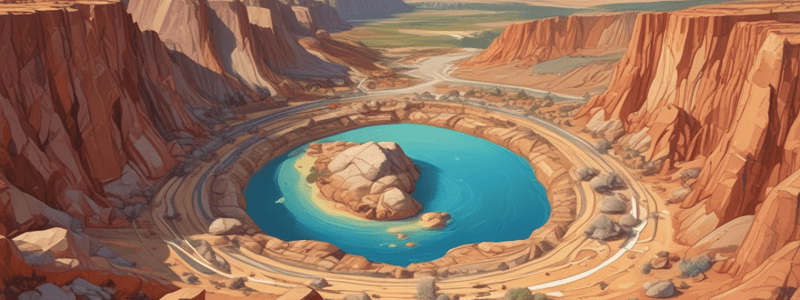Podcast
Questions and Answers
What happens to crystal grains when they recrystallize?
What happens to crystal grains when they recrystallize?
- Some crystals grow into larger crystals and some form into new minerals (correct)
- They disappear completely
- They remain the same size and shape
- They always form into new minerals
What is a characteristic of non-foliated metamorphic rocks?
What is a characteristic of non-foliated metamorphic rocks?
- They have visible layers
- They can be glassy, sandy, or crystalline in texture (correct)
- They have an alignment of crystals
- They always form from sedimentary rocks
What happens to limestone when it is under intense heat and pressure?
What happens to limestone when it is under intense heat and pressure?
- It becomes a foliated metamorphic rock
- It becomes a non-foliated metamorphic rock (correct)
- It becomes a sedimentary rock
- It remains the same
What is an example of a foliated metamorphic rock?
What is an example of a foliated metamorphic rock?
What can happen to metamorphic rocks through weathering and erosion?
What can happen to metamorphic rocks through weathering and erosion?
What is the process that causes sediments to transform into metamorphic rocks?
What is the process that causes sediments to transform into metamorphic rocks?
What can happen to metamorphic rocks that are subducted into the crust?
What can happen to metamorphic rocks that are subducted into the crust?
What is the rock cycle process that occurs when an igneous rock is weathered and eroded?
What is the rock cycle process that occurs when an igneous rock is weathered and eroded?
What is the term for the alignment of crystals, sediments, and minerals in a rock?
What is the term for the alignment of crystals, sediments, and minerals in a rock?
What is the process that occurs when sediments are buried through natural geological processes over time?
What is the process that occurs when sediments are buried through natural geological processes over time?
Flashcards are hidden until you start studying
Study Notes
The Rock Cycle
- The rock cycle is the natural Earth process of how rocks form and convert between types.
- There are three types of rocks: igneous, metamorphic, and sedimentary.
- Rocks can take anywhere from hundreds to thousands of years, to millions of years to form or change types.
Igneous Rocks
- Igneous rocks form from magma or lava, which is liquid rock.
- Magma or lava crystallizes and forms igneous rocks.
- Igneous rocks can be transformed into metamorphic rocks through intense heat and pressure.
- Igneous rocks can be weathered and eroded into sediment and cemented into sedimentary rocks.
- Igneous rocks can also be transformed back into magma.
Sedimentary Rocks
- Sedimentary rocks form from sediments that are broken off other rocks and cemented back together.
- Sediments are formed from metamorphic and igneous rocks and even other sedimentary rocks.
- Weathering is the first step in the sedimentary rock cycle, where tiny pieces break off the original rock.
- Erosion moves the broken pieces of rock away, usually caused by water or wind.
- Sediments are transported and deposited through erosion processes.
- Compaction and cementation are the processes by which sediments stick together to form sedimentary rocks.
Types of Sedimentary Rocks
- Clastic sedimentary rocks form through the basic sedimentary process.
- Bioclastic sedimentary rocks contain pieces of living matter, such as shells or bones.
- Organic sedimentary rocks are formed from the remains of plants and animals, such as coal.
- Chemical sedimentary rocks are formed through the precipitation of minerals from a solution.
Metamorphic Rocks
- Metamorphic rocks are formed from igneous, sedimentary, or other metamorphic rocks through intense pressures and heat.
- Metamorphic rocks physically and chemically change as a result of these processes.
- There are two main processes of metamorphism: contact metamorphism and regional metamorphism.
- Metamorphic rocks can be foliated or non-foliated, with foliated rocks having visible layers.
Rock Cycle Examples
- Sediments and rocks can be buried through natural geological processes over time, leading to metamorphism.
- Metamorphic rocks can melt into magma and crystallize as igneous rocks.
- Igneous rocks can be weathered and eroded away, becoming sedimentary rocks again.
- These processes demonstrate the rock cycle, where rocks can change types through geological processes.
Studying That Suits You
Use AI to generate personalized quizzes and flashcards to suit your learning preferences.




